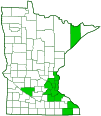Japanese hedge parsley
(Torilis japonica)
Conservation • Weed • Description • Habitat • Ecology • Use • Distribution • Taxonomy
Description |
||
Japanese hedge parsley is native to Europe, Asia, and the Indian subcontinent. It was introduced in North America in 1917 and is now naturalized. In the United States it is widespread but sporadic in the east and in the Pacific Northwest. It is found in natural areas, including open woodlands, woodland edges, savannas, and thickets; and in disturbed sites, including pastures, roadsides, and railroads. It grows under partial sun to full shade, sometimes under full sun, in dry to moderately moist soil. It is considered an aggressively invasive weed here, where it can out-compete native species. Wisconsin lists it as Prohibited/Restricted Invasive - Eradicate! (their emphasis). In Minnesota it is not listed but there is a program to eradicate it in Dakota County parks. Japanese hedge parsley is an erect forb that rises on multiple stems from a thick taproot. It can be 8″ to 48″ tall, but in Minnesota flowering plants are usually no more than 24″ in height. In Minnesota it is a biennial, taking two years to complete its life cycle. In more southerly regions it is an annual. The stems are green, erect, round, grooved, and branched. They are mostly slender but usually stout near the base. They are rough to the touch and are covered with stiff, white, appressed, downward-pointing hairs. In the first year only a radiating cluster (rosette) of basal leaves is produced. These leaves rise from the taproot on long, slender stalks (petioles). The petioles are covered with stiff, white, appressed, downward-pointing hairs, and their margins are rolled inward toward the upper side. The basal leaves are usually present at flowering time. The leaf blade is fern-like, triangular in outline, and up to 6″ (15 cm) long. It is pinnately divided into one or two pairs of opposite leaflets and a terminal leaflet. Each leaflet is lance-shaped to oblong egg-shaped, up to 2⅜″ (6 cm) long, and again pinnately divided into 3 or 5 lobes. The ultimate lobes are sharply pointed at the tip. The upper and lower surfaces are moderately to densely covered with stiff white hairs. The margins have a few sharp teeth. The lowest teeth are deeply cut. Stem leaves are similar to basal leaves. They get progressively smaller, less divided, and shorter stalked as they climb the stem. Lower stem leaves are 2″ to 5″ long, twice pinnate, and on long or short petioles. The base of the petiole surrounds (sheaths) the stem, forming a small cup at the point of attachment. The uppermost stem leaves, just below the inflorescence, are divided into 3 narrowly egg- or lance-shaped leaflets and are short-stalked. The inflorescence is a loose, compound, umbrella-shaped cluster (umbel) at the end of the stem and each branch, and sometimes from an upper leaf axil. The umbel is round, more or less flat-topped, and up to 2″ in diameter. It is at the end of a 1 3⁄16″ to 4¾″ (3 to 12 cm) long stalk (peduncle). The peduncle is covered with stiff, appressed, downward-pointing hairs. The umbel has 5 to 10 slender branches (rays) and is subtended by 3 to 10, narrow, straight-sided (linear), modified leaves (bracts). The bracts are unequal in size. The longest is up to ⅝″ long. All are longer than the arms (raylets) of the associated umbellet. All are covered with stiff, appressed, upward-pointing hairs. Each ray is ⅜″to 1¾″ long and is also covered with stiff, appressed, upward-pointing hairs. At the end of each ray is a smaller, secondary umbel (umbellet). Each umbellet has 5 to 20 raylets and is subtended by 1 to 8 narrowly triangular, linear, or hair-like bractlets. The bractlets are about 3⁄16″ (5 mm) long and are covered with stiff, appressed, upward-pointing hairs. Each raylet is about ⅛″ (3 mm) long and is covered with stiff, appressed, upward-pointing hairs. At the end of each raylet there is a single tiny flower. The flowers are about 3 ⁄16″ (5 mm) wide. Inner flowers of the umbellet are symmetrical on every plane, like a starfish (actinomorphic). Outer flowers are sometimes symmetrical on only one plane (zygomorphic). There are 5 outer floral leaves (sepals), 5 petals, 5 stamens, and 2 styles. The sepals are very small, less than 1⁄64″ (0.5 mm) long. The petals are white, inversely egg-shaped, and deeply notched at the tip. The outer petals of the outer flowers are enlarged, up to 1⁄16″ (2 mm) long, and broad. The stamens are small and have white anthers. The styles are green. The fruit is an oblong-elliptic to egg-shaped, 1⁄16″ to ⅛″ (2 to 4 mm) long, ⅛″ (3 mm) wide capsule containing 2 seeds. It is whitish green at first, turning dark brown at maturity. It is densely covered with 1⁄64″ to 1⁄32″ (0.4 to 0.8 mm) long hooked hairs that will stubbornly cling to any fabric. |
||
Height |
||
8″ to 48″ |
||
Flower Color |
||
White |
||
Similar Species |
||
Spreading hedge parsley (Torilis arvensis) umbels do not have bracts below each umbel. |
||
Habitat |
||
Dry to moderately moist. Open woodlands, woodland edges, savannas, thickets, pastures, roadsides, and railroads. Full shade to full sun. |
||
Ecology |
||
Flowering |
||
June to August |
||
Pests and Diseases |
||
|
||
Use |
||
|
||
Distribution |
||||
|
Sources |
|||
| 5/2/2023 | ||||
Nativity |
||||
Native to Europe, Asia, and the Indian subcontinent. Introduced and naturalized in North America. |
||||
Occurrence |
||||
Widespread and sporadic |
||||
Taxonomy |
|||
| Kingdom | Plantae (Plants) | ||
| Subkingdom | Pteridobiotina | ||
| Phylum | Tracheophyta (Vascular Plants) | ||
| Class | Magnoliopsida (Dicots) | ||
Order |
Apiales (Carrots, Ivies, and Allies) | ||
| Suborder | Apiineae | ||
Family |
Apiaceae (carrot) | ||
| Subfamily | Apioideae | ||
| Tribe | Scandiceae | ||
| Subtribe | Torilidinae | ||
Genus |
Torilis (hedge parslies) | ||
Subordinate Taxa |
|||
|
|||
Synonyms |
|||
Torilis anthriscus |
|||
Common Names |
|||
erect hedge parsley erect hedgeparsley Japanese hedge parsley upright hedge-parsley |
|||
Glossary
Axil
The upper angle where a branch, stem, leaf stalk, or vein diverges.
Bract
Modified leaf at the base of a flower stalk, flower cluster, or inflorescence.
Bractlet
A small, often secondary bract within an inflorescence; a bract that is borne on a petiole instead of subtending it; bracteole.
Elliptic
Narrowly oval, broadest at the middle, narrower at both ends, with the ends being equal.
Linear
Long, straight, and narrow, with more or less parallel sides, like a blade of grass.
Oblong
Two to four times longer than wide with nearly parallel sides.
Peduncle
In angiosperms, the stalk of a single flower or a flower cluster; in club mosses, the stalk of a strobilus or a group of strobili.
Petiole
On plants: The stalk of a leaf blade or a compound leaf that attaches it to the stem. On ants and wasps: The constricted first one or two segments of the rear part of the body.
Pinnate
On a compound leaf, having the leaflets arranged on opposite sides of a common stalk. On a bryophyte, having branches evenly arranged on opposite sides of a stem.
Ray
In the Asteraceae (aster) family: a strap-shaped flower, or the strap-shaped portion of a flower. In the Apiaceae (carrot) and Euphorbiaceae (spurge) families: a branch of an umbel.
Raylet
A branch of an umbellet.
Rosette
A radiating group or cluster of leaves usually on or close to the ground.
Sepal
An outer floral leaf, usually green but sometimes colored, at the base of a flower.
Sheath
The lower part of the leaf that surrounds the stem.
Umbel
A flat-topped or convex, umbrella-shaped cluster of flowers or buds arising from more or less a single point.
Umbellet
A secondary umbel in a compound umbel.
Visitor Photos |
|||||
Share your photo of this plant. |
|||||
| This button not working for you? Simply email us at info@MinnesotaSeasons.com. Attach one or more photos and, if you like, a caption. |
|||||
|
|||||
MinnesotaSeasons.com Photos |
|||||
Plant |
|||||
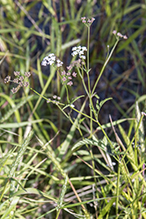 |
|||||
Inflorescence |
|||||
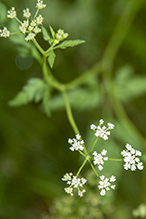 |
|||||
Leaves |
|||||
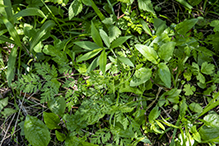 |
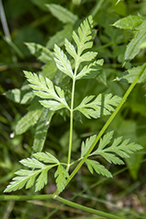 |
||||

Slideshows |
||

Visitor Videos |
|||
Share your video of this plant. |
|||
| This button not working for you? Simply email us at info@MinnesotaSeasons.com. Attach a video, a YouTube link, or a cloud storage link. |
|||
Other Videos |
|||
| Japanese Hedge Parsley, identification of the Wisconsin Invasive Species Torilis japonica University of Wisconsin Extension |
|||
About
Jul 26, 2011 This is part of a series of videos providing key characteristics for the identification of invasive plants listed in Wisconsin's invasive species administrative rule NR 40. These videos are produced by Dr. Mark Renz of the University of Wisconsin-Madison. For more information on invasive plants and invasive plant management in Wisconsin visit http://fyi.uwex.edu/weedsci |
|||
| Ant forages on Torilis japonica Robert Klips |
|||
About
Jul 25, 2012 Erect hedgeparsely, Torilis japonica (Apiaceae, the parsley, or celery, or carrot, or whatever it is family) is an invasive weed in northeastern Ohio, where this video was taken on July 24, 2012. The ants seem to like it. I wonder what they're eating: pollen, nectar, or both? |
|||

Visitor Sightings |
|||||
Report a sighting of this plant. |
|||||
| This button not working for you? Simply email us at info@MinnesotaSeasons.com. Be sure to include a location. |
|||||
| Jeri Aug thru Oct of 2022 |
Location: 45819 404th Ave Mazeppa, Wabasha County, MN We carefully disposed of and bagged dozens of these plants in the last 2 years. |
||||
MinnesotaSeasons.com Sightings |
|||||

Created: 6/7/2020
Last Updated:
